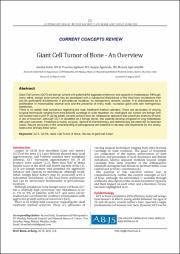| dc.contributor.author | Sobti, Anshul | en_US |
| dc.contributor.author | Agrawal, Pranshu | en_US |
| dc.contributor.author | Agarwala, Sanjay | en_US |
| dc.contributor.author | Agarwal, Manish | en_US |
| dc.date.accessioned | 1399-07-09T12:56:35Z | fa_IR |
| dc.date.accessioned | 2020-09-30T12:56:35Z | |
| dc.date.available | 1399-07-09T12:56:35Z | fa_IR |
| dc.date.available | 2020-09-30T12:56:35Z | |
| dc.date.issued | 2016-01-01 | en_US |
| dc.date.issued | 1394-10-11 | fa_IR |
| dc.date.submitted | 2015-03-12 | en_US |
| dc.date.submitted | 1393-12-21 | fa_IR |
| dc.identifier.citation | Sobti, Anshul, Agrawal, Pranshu, Agarwala, Sanjay, Agarwal, Manish. (2016). Giant Cell Tumor of Bone - an Overview. The Archives of Bone and Joint Surgery, 4(1), 2-9. doi: 10.22038/abjs.2016.4701 | en_US |
| dc.identifier.issn | 2345-4644 | |
| dc.identifier.issn | 2345-461X | |
| dc.identifier.uri | https://dx.doi.org/10.22038/abjs.2016.4701 | |
| dc.identifier.uri | http://abjs.mums.ac.ir/article_4701.html | |
| dc.identifier.uri | https://iranjournals.nlai.ir/handle/123456789/431432 | |
| dc.description.abstract | <br/><span style="font-size: xx-small;">Giant Cell tumors (GCT) are benign tumors with potential for aggressive behavior and capacity to metastasize. Although rarely lethal, benign bone tumors may be associated with a substantial disturbance of the local bony architecture that can be particularly troublesome in peri-articular locations. Its histogenesis remains unclear. It is characterized by a proliferation of mononuclear stromal cells and the presence of many multi- nucleated giant cells with homogenous distribution. </span><br/><span style="font-size: xx-small;">There is no widely held consensus regarding the ideal treatment method selection. There are advocates of varying surgical techniques ranging from intra-lesional curettage to wide resection. As most giant cell tumors are benign and are located near a joint in young adults, several authors favor an intralesional approach that preserves anatomy of bone </span><span style="font-family: Arial,Arial; font-size: xx-small;"><span style="font-family: Arial,Arial; font-size: xx-small;">in lieu of resection. Although GCT is classified as a benign lesion, few patients develop progressive lung metastases </span></span><span style="font-size: xx-small;">with poor outcomes. Treatment is mainly surgical. Options of chemotherapy and radiotherapy are reserved for selected cases. Recent advances in the understanding of pathogenesis are essential to develop new treatments for this locally destructive primary bone tumor. </span> | en_US |
| dc.format.extent | 340 | |
| dc.format.mimetype | application/pdf | |
| dc.language | English | |
| dc.language.iso | en_US | |
| dc.publisher | Mashhad University of Medical Sciences, Iranian Society of Knee Surgery, Arthroscopy and Sports Tramatology,Iranian Orthopaedic Association | en_US |
| dc.relation.ispartof | The Archives of Bone and Joint Surgery | en_US |
| dc.relation.isversionof | https://dx.doi.org/10.22038/abjs.2016.4701 | |
| dc.subject | GCT | en_US |
| dc.subject | GCTB | en_US |
| dc.subject | Giant cell tumor of bone | en_US |
| dc.subject | Review of giant cell tumor | en_US |
| dc.title | Giant Cell Tumor of Bone - an Overview | en_US |
| dc.type | Text | en_US |
| dc.type | CURRENT CONCEPTS REVIEW | en_US |
| dc.contributor.department | Department of Orthopaedics, P.D Hinduja National
Hospital and Medical Research Centre, Veer Savarkar
Marg, Mahim, Mumbai, India | en_US |
| dc.contributor.department | Department of Orthopaedics, P.D Hinduja National
Hospital and Medical Research Centre, Veer Savarkar
Marg, Mahim, Mumbai, India | en_US |
| dc.contributor.department | Head of Surgey & Orthopaedics, Consultant in
Orthopaedics Trauma & Arthroplasty, P.D Hinduja
National Hospital and Medical Research Centre, Veer
Savarkar Marg Mahim, Mumbai, India | en_US |
| dc.contributor.department | Consultant in Orthopaedic Oncology & Soft Tissue
Tumors, Hinduja National Hospital and Medical
Research Centre, Veer Savarkar Marg Mahim, Mumbai,
India | en_US |
| dc.citation.volume | 4 | |
| dc.citation.issue | 1 | |
| dc.citation.spage | 2 | |
| dc.citation.epage | 9 | |





